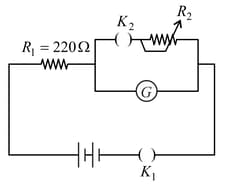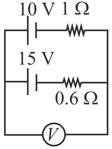EASY
Earn 100
An ammeter has a resistance of and a range of . The value of resistance used in parallel to convert it into an ammeter of the range is
(a)
(b)
(c)
(d)
50% studentsanswered this correctly
Important Questions on Moving Charges and Magnetism
MEDIUM
The galvanometer deflection, when key is closed but is open, equals (see figure). On closing also and adjusting to the deflection in galvanometer becomes The resistance of the galvanometer is, then, given by [Neglect the internal resistance of battery]:

MEDIUM
MEDIUM
EASY
Higher the range, greater is the resistance of ammeter.
To increase the range of ammeter, additional shunt needs to be used across it.
MEDIUM
Distinguish between ammeter and voltmeter.
EASY
MEDIUM
HARD
MEDIUM
EASY
EASY

EASY
EASY
MEDIUM
EASY

MEDIUM
EASY
MEDIUM
Derive the expression for the torque acting on the rectangular current carrying coil of a galvanometer. Why is the magnetic field made radial?
MEDIUM
How do you convert a moving coil galvanometer into an ammeter?
EASY

